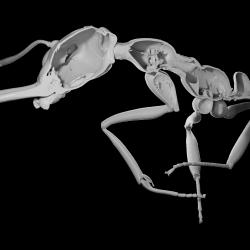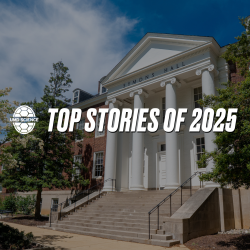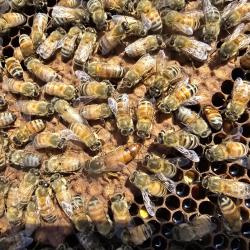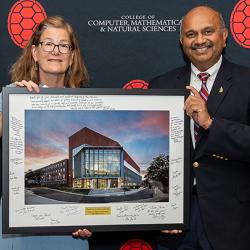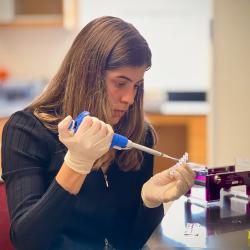Five College Faculty Members Named 2019 Highly Cited Researchers
Sankar Das Sarma, Christopher Monroe, Ian Spielman, Dennis vanEngelsdorp and Chunsheng Wang received the honor
Five faculty members in the University of Maryland’s College of Computer, Mathematical, and Natural Sciences are included on the Web of Science Group’s 2019 list of Highly Cited Researchers, a compilation of influential names in science.
- Sankar Das Sarma, Richard E. Prange Chair and Distinguished University Professor of Physics, Joint Quantum Institute (JQI) Fellow and Condensed Matter Theory Center Director. Das Sarma was included in all previous compilations of this list in 2018, 2017, 2016, 2015, 2014 and 2001.
- Christopher Monroe, Distinguished University Professor and Bice Zorn Professor of Physics, JQI Fellow and Joint Center for Quantum Information and Computer Science (QuICS) Fellow. He also co-founded IonQ, an early-stage company developing quantum computing for commercial applications.
- Ian Spielman, Adjunct Professor of Physics, JQI Fellow and National Institute of Standards and Technology (NIST) Fellow. Spielman was also included in the 2018 and 2017 compilations.
- Dennis vanEngelsdorp, Associate Professor of Entomology and President of the Bee Informed Partnership. VanEngelsdorp was also included in the 2018, 2017 and 2016 compilations.
- Chunsheng Wang, Professor of Chemistry and Biochemistry, Professor and Robert Franklin and Frances Riggs Wright Distinguished Chair of Chemical and Biomolecular Engineering and UMD Director of the Center for Research in Extreme Batteries. Wang was also included in the 2018 compilation.
Das Sarma’s research interests include condensed matter physics, statistical mechanics and quantum information. A theoretical condensed matter physicist, Das Sarma has worked in the areas of strongly correlated materials, graphene, semiconductor physics, low-dimensional systems, topological matter, quantum Hall effect, nanoscience, spintronics, collective properties of ultra-cold atomic and molecular systems, optical lattice, many-body theory, Majorana fermion, and quantum computation. Das Sarma’s introduction of the nu=5/2 topological qubit in 2005 with Microsoft Research colleagues Chetan Nayak and Michael Freedman, and his 2010 theoretical predictions of special particles called Majorana fermions in semiconductor nanowires have led to experiments in building scalable, fault-tolerant quantum computers based on two-dimensional semiconductor structures or nanowires.
Das Sarma, a physics faculty member at UMD since 1980, earned his undergraduate degree in physics in 1973 from Presidency College in Kolkata, India, and his Ph.D. in theoretical condensed physics in 1979 from Brown University.
Monroe is a leading researcher in atomic physics and quantum information science. Early in his career, he led the team that demonstrated the first quantum logic gate in any physical platform. Later he pioneered the use of photons to couple quantum information between atoms and demonstrated the first electromagnetic atom trap integrated on a semiconductor chip. Since 2007, his group has pioneered the use of individual atoms for quantum simulations of many-body models related to quantum magnetism. More recently he has proposed and made the first steps toward a scalable, reconfigurable, and modular quantum computer. In 2016, he co-founded the startup company IonQ, which makes high performance quantum computers and has raised $80 million in venture capital.
Monroe joined UMD in 2007. He earned his B.S. in physics from the Massachusetts Institute of Technology in 1987 and his Ph.D. in physics from the University of Colorado in 1992.
Spielman combines experimental and theoretical techniques to study systems of ultracold atoms, which comprise several hundred to several hundred million atoms at temperatures close to absolute zero. Spielman’s focus is making these systems, which have applications in quantum computing, behave like electrons in conventional materials. For example, he has used lasers to manipulate ultracold atoms into moving like charged particles in a magnetic field. His group made cold atoms analogous to modern spintronic materials—often used in semiconductor devices—by introducing Rashba and Dresselhaus spin-orbit couplings. Spielman’s work also touches on novel charge pumps that use the geometry and topology of quantum states and may lead to high-efficiency electronic devices. Recently, he created a cold-atom analog to the five-dimensional Yang monopole, which could lead to new types of quantum charge pumps.
Spielman joined UMD in 2006. He earned his B.S. in physics and mathematics from the University of Oklahoma in 1998 and his Ph.D. in physics from the California Institute of Technology in 2004.
VanEngelsdorp’s research focuses on using an epidemiological approach to assess honey bee health. His research group is a world leader in the study of major mechanisms responsible for the decline in honey bee health, including an increase in pests and pathogens, poor nutrition due to the loss of natural forage and pesticides applied by both beekeepers and farmers. VanEngelsdorp’s approach is multifaceted, addressing both the etiology of individual bee diseases and the large-scale monitoring of colony health. He is also the founding president of the Bee Informed Partnership Inc., a not for profit dedicated to funding honey bee surveillance systems with the intent of reducing honey bee colony losses. In combination with annual nationwide surveys, the Bee Informed Partnership also works directly with beekeepers to help gather pest and disease data and validate trends in management practices.
VanEngelsdorp joined UMD in 2012. He earned his undergraduate degree in agriculture in 1992 and his master’s degree in environmental biology in 1995 from the University of Guelph in Ontario, Canada, and his Ph.D. from the Pennsylvania State University in 2011.
Wang studies and develops advanced materials for safe high-energy batteries that have applications in renewable energy, consumer electronics, electric vehicles and more. In 2015, Wang invented water-in-salt electrolytes for lithium-ion batteries and zinc-air batteries in collaboration with scientists from the U.S. Army Research Laboratory. These inventions opened a new area of high-voltage aqueous electrochemistry and battery research. In 2018, Wang led a collaboration among UMD, the Army Research Laboratory and the Brookhaven National Laboratory that developed and studied a new material that could triple the energy density of lithium-ion battery electrodes. In another study, Wang led a team in developing a non-flammable, high-voltage lithium-ion electrolyte that allowed the creation of batteries with higher energy storage capacity, more efficiency and better safety than current batteries. Recently, Wang’s group invented "super electrolytes" that are capable of operating in extreme temperatures, from the arctic tundra to the african savannah, as well as transition-metal free conversion-intercalation cathodes. Wang also searches for alternatives to lithium-based batteries, including sodium-ion batteries, magnesium/iodine batteries and solid-state lithium metal batteries.
Wang joined UMD in 2007. He earned his B.S in mechanical engineering from Jiamusi University in China in 1982, his M.S. in materials science and engineering from the Harbin Institute of Technology in China in 1988, and his Ph.D. in materials science and engineering from Zhejiang University in China in 1995.
The Highly Cited Researchers list features more than 6,200 authors—some 3,700 in specific fields and about 2,500 across fields—in 21 science and social science disciplines. The scientists’ published work in their specialty areas or across multiple areas has consistently been judged by their peers to be of particular use and significance. These researchers earned the distinction by writing the greatest numbers of reports officially designated by Essential Science Indicators (ESI) as Highly Cited Papers—ranking among the top 1 percent most cited for their subject field or across multiple fields and year of publication. The 2019 Highly Cited Researchers list is drawn from data contained in the ESI spanning 2008-2018.
The Highly Cited Researchers list is one of several criteria used by the Center for World-Class Universities at Shanghai Jiao Tong University to determine the Academic Ranking of World Universities.
###
Media Relations Contact: Matthew Wright, 301-405-9267, mewright@umd.edu
University of Maryland
College of Computer, Mathematical, and Natural Sciences
2300 Symons Hall
College Park, MD 20742
www.cmns.umd.edu
@UMDscience
About the College of Computer, Mathematical, and Natural Sciences
The College of Computer, Mathematical, and Natural Sciences at the University of Maryland educates more than 9,000 future scientific leaders in its undergraduate and graduate programs each year. The college's 10 departments and more than a dozen interdisciplinary research centers foster scientific discovery with annual sponsored research funding exceeding $175 million.



